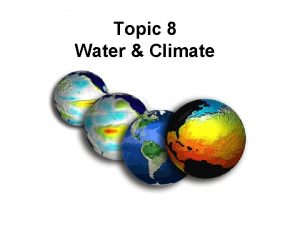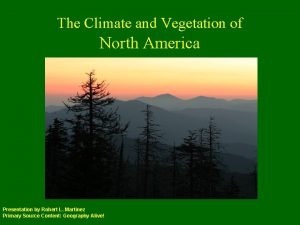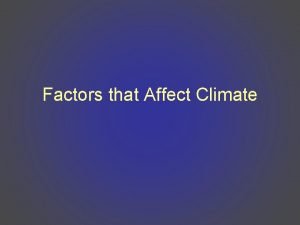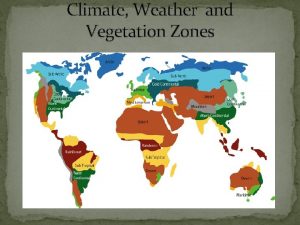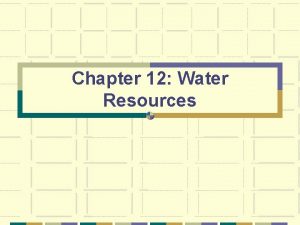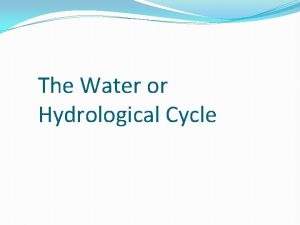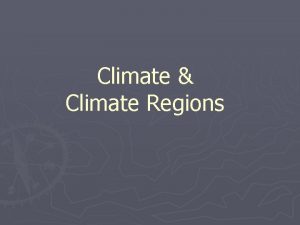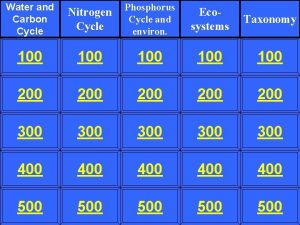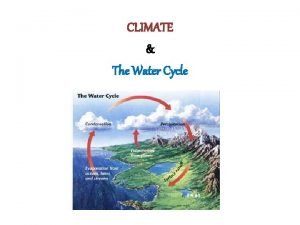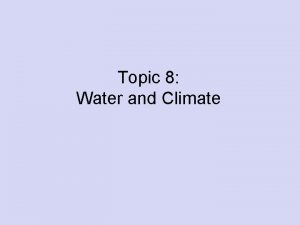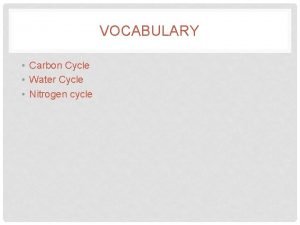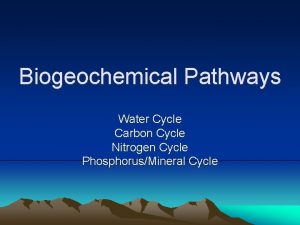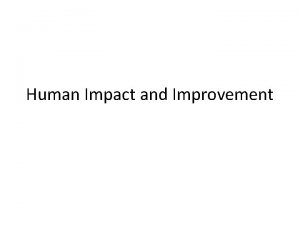Water Cycle and Climate The water cycle is























































- Slides: 55

Water Cycle and Climate The water cycle is the circulation of water from the surface of Earth into the atmosphere and back again (evaporation, condensation, precipitation).


Precipitation may infiltrate Earth’s surface, runoff, or evaporate.

The release of water vapor into the atmosphere by plants is called transpiration.

Earth has been continuously been recycling water since the outgassing of water early in it’s history.

Water movement in the ground.

less than 3 percent of Earth’s water is fresh, and over two thirds of that is frozen. Most usable fresh water is underground.


Infiltration can occur if the surface is permeable and unsaturated and the slope is gentle enough.


The rate of infiltration is determined by the porosity and permeability of the soil.

Porosity is the percentage of open space in a sample compared with its total volume.

Porosity is determined by the shape of the particles, how they are packed, and whether or not they are sorted by size.

Particle size does not affect porosity. A 500 ml sample of small beads and a 500 ml of large beads will have the same percentage of porosity.

The permeability of a material is a measure of how fast water will pass through it.

Permeability depends on pore size and whether or not the pores are interconnected.

Permeability increases as pore size increases.

• http: //www. eram. k 12. ny. us/education/page /download. php? fileinfo=c. GVyb. S 5 wb 3 Jvcy 5 zd 2 Y 6 Ojovd 3 d 3 L 3 Nja. G 9 vb. HMvc 2 Mvcm Vtb 3 Rl. L 2 lt. YWdlcy 9 kb 2 Nt. Z 3 Iv. NDQ 3 Zmls. Z TE 3 NDcuc 3 dm

Runoff can occur when rainfall exceeds the permeability rate, when the soil is saturated, or when the slope is too great to allow time for infiltration.

Capillarity is the upward movement of water into tiny pore spaces.


Zone of Saturation – Ground water zone where all available pore spaces are filled with water.


Water Table – The top of the zone of saturation.


Zone of aeration – Zone that extends from the surface to the water table. Pore spaces may be moist but are not saturated.



A productive well must extend below the water table into the zone of saturation.


Climate

Climate is the average weather for a region over a long period of time.

Climate is usually described in terms of precipitation and temperature.

Local climates can be influenced by latitude, being near a large body of water, ocean currents, prevailing winds, vegetative cover, elevation, as well as many other factors.

Human influences on climate include deforestation, urbanization, and the production of greenhouse gases such as carbon dioxide.

Moderating effect of nearby large bodies of water.

Land heats up and cools down much more quickly than water because it has a lower specific heat.

Throughout the year the temperature of the ocean doesn't change as much as the temperature of the land.

Locations near large bodies of water (like us) usually have cooler summers and warmer winters.

Inland locations are usually hotter during the summer and colder during the winter.

Effect of altitude and latitude on climate.

Places at low latitudes are warm because they receive a high angle of insolation.

Places at high latitudes are cold because they receive a low angle of insolation.

Locations at high altitudes are cool.

Locations at low altitudes tend to be warmer.

Windward and Leeward Climates

The windward side of a mountain is the side that the prevailing winds blow against. In the U. S. this is the west side of the mountain.

The leeward side of a mountain is the other side.

Wind blowing against a mountain is forced to rise.

Rising air expands and cools, condensing into clouds.

Places on the windward side of a mountain (Seattle) receive a lot of precipitation.

When the wind blows down the leeward side of the mountain, it becomes compressed, dry, and warm.

Places on the windward side of a mountain tend to have a dry climate.


 Water and water and water water
Water and water and water water Climate change 2014 mitigation of climate change
Climate change 2014 mitigation of climate change Mountain humidity
Mountain humidity How is the carbon cycle similar to the water cycle brainpop
How is the carbon cycle similar to the water cycle brainpop Water cycle the hydrologic cycle
Water cycle the hydrologic cycle Hát kết hợp bộ gõ cơ thể
Hát kết hợp bộ gõ cơ thể Ng-html
Ng-html Bổ thể
Bổ thể Tỉ lệ cơ thể trẻ em
Tỉ lệ cơ thể trẻ em Chó sói
Chó sói Chụp phim tư thế worms-breton
Chụp phim tư thế worms-breton Bài hát chúa yêu trần thế alleluia
Bài hát chúa yêu trần thế alleluia Các môn thể thao bắt đầu bằng tiếng nhảy
Các môn thể thao bắt đầu bằng tiếng nhảy Thế nào là hệ số cao nhất
Thế nào là hệ số cao nhất Các châu lục và đại dương trên thế giới
Các châu lục và đại dương trên thế giới Công của trọng lực
Công của trọng lực Trời xanh đây là của chúng ta thể thơ
Trời xanh đây là của chúng ta thể thơ Mật thư tọa độ 5x5
Mật thư tọa độ 5x5 Phép trừ bù
Phép trừ bù Phản ứng thế ankan
Phản ứng thế ankan Các châu lục và đại dương trên thế giới
Các châu lục và đại dương trên thế giới Thơ thất ngôn tứ tuyệt đường luật
Thơ thất ngôn tứ tuyệt đường luật Quá trình desamine hóa có thể tạo ra
Quá trình desamine hóa có thể tạo ra Một số thể thơ truyền thống
Một số thể thơ truyền thống Bàn tay mà dây bẩn
Bàn tay mà dây bẩn Vẽ hình chiếu vuông góc của vật thể sau
Vẽ hình chiếu vuông góc của vật thể sau Nguyên nhân của sự mỏi cơ sinh 8
Nguyên nhân của sự mỏi cơ sinh 8 đặc điểm cơ thể của người tối cổ
đặc điểm cơ thể của người tối cổ Ví dụ về giọng cùng tên
Ví dụ về giọng cùng tên Vẽ hình chiếu đứng bằng cạnh của vật thể
Vẽ hình chiếu đứng bằng cạnh của vật thể Vẽ hình chiếu vuông góc của vật thể sau
Vẽ hình chiếu vuông góc của vật thể sau Thẻ vin
Thẻ vin đại từ thay thế
đại từ thay thế điện thế nghỉ
điện thế nghỉ Tư thế ngồi viết
Tư thế ngồi viết Diễn thế sinh thái là
Diễn thế sinh thái là Dot
Dot Số nguyên là gì
Số nguyên là gì Tư thế ngồi viết
Tư thế ngồi viết Lời thề hippocrates
Lời thề hippocrates Thiếu nhi thế giới liên hoan
Thiếu nhi thế giới liên hoan ưu thế lai là gì
ưu thế lai là gì Sự nuôi và dạy con của hổ
Sự nuôi và dạy con của hổ Sự nuôi và dạy con của hổ
Sự nuôi và dạy con của hổ Hệ hô hấp
Hệ hô hấp Từ ngữ thể hiện lòng nhân hậu
Từ ngữ thể hiện lòng nhân hậu Thế nào là mạng điện lắp đặt kiểu nổi
Thế nào là mạng điện lắp đặt kiểu nổi Vegetation region map of canada
Vegetation region map of canada Vegetation of north america
Vegetation of north america Scandinavian climate and geography
Scandinavian climate and geography How does wind affect weather and climate
How does wind affect weather and climate Weather climate and society
Weather climate and society How do prevailing winds affect climate
How do prevailing winds affect climate Which colonial region contained rocky soil and cold climate
Which colonial region contained rocky soil and cold climate Climate and vegetation zones
Climate and vegetation zones Climate change meaning
Climate change meaning


